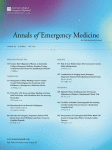 A journal has temporarily removed a paper showing the dramatic differences in the cost of providing emergency care that caught national attention (and some criticism from emergency care providers), despite the first author’s claims that the results are valid.
A journal has temporarily removed a paper showing the dramatic differences in the cost of providing emergency care that caught national attention (and some criticism from emergency care providers), despite the first author’s claims that the results are valid.
The paper, published online in February by the Annals of Emergency Medicine, showed that it can cost significantly more for patients to be treated at emergency departments than at urgent care centers, even for the same conditions. Soon after the paper was published, first author Vivian Ho at Rice University was told by the American College of Emergency Physicians, which publishes the journal, that there were some errors in the appendix, and they wanted to reanalyze the entire paper.
Ho told us:
They’re saying because there are errors in the appendix, the entire study is wrong.
Ho said she took a second look at the appendix, and realized there were, in fact, errors — in some instances, the wrong cell was put in the wrong column of a spreadsheet, leading to some incorrect numbers. But it was an “honest error,” she said, and didn’t affect the overall paper:
[The transcription errors] are in an appendix. They don’t affect the main results in the paper.
Ho submitted a correction to fix the issue in the appendix. She then received a letter listing concerns with the paper, which Ho told us she is still reviewing. Ho stands by her paper:
I would completely [retract the paper] if [the error affected] the main findings of the paper. But they’re still solid.
The journal clearly disagrees, as it has temporarily removed the paper “Comparing Utilization and Costs of Care in Freestanding Emergency Departments, Hospital Emergency Departments, and Urgent Care Centers,” providing only a generic note that Elsevier uses in cases when an article is in press but not assigned to an issue yet:
The publisher regrets that this article has been temporarily removed. A replacement will appear as soon as possible in which the reason for the removal of the article will be specified, or the article will be reinstated.
The article reviewed insurance data from places that offer emergency care in Texas: hospitals, free-standing emergency departments, and urgent care centers. It found emergency departments charge sometimes 10 times more to treat the same conditions as urgent care centers. Ho said:
The point of this was to say ‘look, there are a lot of customers getting fooled, because they’re paying higher prices.’
The analysis was even mentioned in a Washington Post article this week about the rise of free-standing ERs. The dispute over the withdrawal was covered extensively this week by Health Data Buzz.
Ho forwarded us some of her correspondence with the journal, which confirmed that their initial concerns focused on some figures in the appendix. However, once she submitted a correction for the mistakes, she received word the journal was conducting another investigation, triggered by emergency physicians with reimbursement expertise in Texas, who raised additional concerns about the accuracy of the data.
Ho told us she disputes with the nature of the most recent allegations, and stands by the paper’s main findings. She added she believes the removal is politically motivated, as the paper has been criticized by representatives of emergency departments.
We’ve contacted the editor of the journal, Michael Callaham at the University of California, San Francisco, who told us the decision for how to proceed with the article will be based “only on our own objective and currently confidential assessment:”
Dr. Ho’s statements represent what she believes to be true. Others see it differently, as often happens in scientific peer review. From the beginning we have followed the recommended ICMJE, WAME, and COPE algorithms and guidelines for dealing with such issues, and have also consulted with the ethics consultants at our publisher, Elsevier. Our obligation is to arrive at an assessment entirely within the journal editorial structure, which we are doing (and which is guaranteed in my editor contract, in accordance with ICMJE recommendations). There have been plenty of politics and dramatic public claims involved but our decision will be based only on our own objective and currently confidential assessment. We have provided Dr Ho a detailed set of concerns and asked for her written response, which we have not yet received. We were also informed that she has asked Blue Shield/Blue Cross to arrange an independent third party review of the dataset they provided to her, but have heard nothing further on that point either.
We also received a statement from the American College of Emergency Physicians, which publishes the journal:
Annals of Emergency Medicine is an independent journal. The journal is published by the American College of Emergency Physicians (ACEP), but ACEP has no control over its content or the editorials. ACEP completely supports and protects the independence of its journal…The Editor-in-Chief of the journal made the decision to pull the paper and conduct an independent review, following significant questions being raised by reimbursement experts about the data. The review follows strict protocols, and the Editor-in-Chief has the full authority to decide whether the article will be published.
Like Retraction Watch? Consider making a tax-deductible contribution to support our growth. You can also follow us on Twitter, like us on Facebook, add us to your RSS reader, sign up on our homepage for an email every time there’s a new post, or subscribe to our daily digest. Click here to review our Comments Policy. For a sneak peek at what we’re working on, click here.